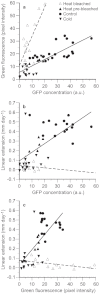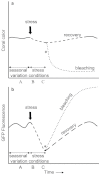Effects of cold stress and heat stress on coral fluorescence in reef-building corals
- PMID: 23478289
- PMCID: PMC3594756
- DOI: 10.1038/srep01421
Effects of cold stress and heat stress on coral fluorescence in reef-building corals
Abstract
Widespread temperature stress has caused catastrophic coral bleaching events that have been devastating for coral reefs. Here, we evaluate whether coral fluorescence could be utilized as a noninvasive assessment for coral health. We conducted cold and heat stress treatments on the branching coral Acropora yongei, and found that green fluorescent protein (GFP) concentration and fluorescence decreased with declining coral health, prior to initiation of bleaching. Ultimately, cold-treated corals acclimated and GFP concentration and fluorescence recovered. In contrast, heat-treated corals eventually bleached but showed strong fluorescence despite reduced GFP concentration, likely resulting from the large reduction in shading from decreased dinoflagellate density. Consequently, GFP concentration and fluorescence showed distinct correlations in non-bleached and bleached corals. Green fluorescence was positively correlated with dinoflagellate photobiology, but its closest correlation was with coral growth suggesting that green fluorescence could be used as a physiological proxy for health in some corals.
Figures





References
-
- Costanza R. et al. The value of the world's ecosystem services and natural capital. Nature 387, 253–260 (1997).
-
- Hughes T. P. et al. Climate change, human impacts, and the resilience of coral reefs. Science 301, 929–933 (2003). - PubMed
-
- Hoegh-Guldberg O. et al. Coral reefs under rapid climate change and ocean acidification. Science 318, 1737–1742 (2007). - PubMed
-
- Baker A. C., Glynn P. W. & Riegl B. Climate change and coral reef bleaching: An ecological assessment of long-term impacts, recovery trends and future outlook. Estuar. Coast. Shelf Sci. 80, 435–471 (2008).
Publication types
MeSH terms
Substances
LinkOut - more resources
Full Text Sources
Other Literature Sources

